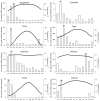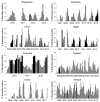Timing of influenza A(H5N1) in poultry and humans and seasonal influenza activity worldwide, 2004-2013
- PMID: 25625302
- PMCID: PMC4313643
- DOI: 10.3201/eid2102.140877
Timing of influenza A(H5N1) in poultry and humans and seasonal influenza activity worldwide, 2004-2013
Abstract
Co-circulation of influenza A(H5N1) and seasonal influenza viruses among humans and animals could lead to co-infections, reassortment, and emergence of novel viruses with pandemic potential. We assessed the timing of subtype H5N1 outbreaks among poultry, human H5N1 cases, and human seasonal influenza in 8 countries that reported 97% of all human H5N1 cases and 90% of all poultry H5N1 outbreaks. In these countries, most outbreaks among poultry (7,001/11,331, 62%) and half of human cases (313/625, 50%) occurred during January-March. Human H5N1 cases occurred in 167 (45%) of 372 months during which outbreaks among poultry occurred, compared with 59 (10%) of 574 months that had no outbreaks among poultry. Human H5N1 cases also occurred in 59 (22%) of 267 months during seasonal influenza periods. To reduce risk for co-infection, surveillance and control of H5N1 should be enhanced during January-March, when H5N1 outbreaks typically occur and overlap with seasonal influenza virus circulation.
Figures




References
-
- Kamps BS, Hoffmann C, Preiser W, editors. Influenza report 2006. Paris: Flying Publisher; 2006.
Publication types
MeSH terms
LinkOut - more resources
Full Text Sources
Other Literature Sources
Medical

